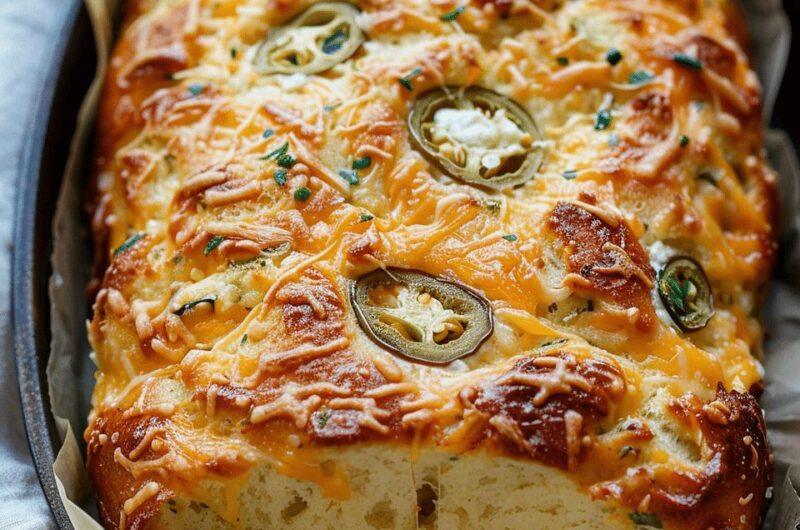No Knead Jalapeño Cheddar Bread
Baking bread that tastes straight out of a rustic bakery doesn’t have to be complicated. This jalapeño–cheddar loaf comes out of the Dutch oven with a bold, crackly crust and melty cheese swirls—yet you barely have to touch the dough.
I first shared this recipe back in 2018, but since then I’ve polished it up with clearer steps, fresh photos, and even a video guide so you can follow along with ease.
When I first posted my cranberry nut no-knead bread, so many of you asked for more twists on the same easy method. That led to olive bread, a hearty seeded oat loaf, a so-called “plain” artisan bread that’s anything but ordinary, and even a skillet version crowned with an asiago crust. And then came this jalapeño–cheddar bread. It’s been on my site for a few years now, but I’ve just refreshed it with sharper photos and cleaner, easier-to-follow directions.
What’s the first thing you picture when someone mentions homemade bread? For most folks who don’t bake often, the idea feels a little intimidating. But this recipe flips that fear on its head. With just a quick stir of a few ingredients, you’ll have a loaf that looks and tastes like it came from a bakery—without the endless kneading or fussy steps.
How to Make Jalapeño Cheddar No-Knead Bread
- Mix together just six simple ingredients—flour, yeast, salt, sharp cheddar, diced jalapeños, and water. No mixer, no fuss.
- Form the dough into a rough ball, then forget about it while time does the work.
- When it’s ready, slash an “X” across the top, give it a short rest, and slide it into a Dutch oven. Out comes a loaf with a golden, shatter-crisp crust.
- Slice it. Tear it. Devour it warm.
And that’s the beauty of it. This no-knead technique has made its way from New York City to kitchens everywhere, all thanks to Jim Lahey of Sullivan Street Bakery. The ingredients couldn’t be simpler, yet his method turned bread baking on its head with one genius twist—an 18-hour rise. That long, slow rest lets the dough ferment and build incredible flavor while it just sits on your counter. No kneading, no arm workout, no stress. You leave it alone, and the dough quietly transforms while you sleep.
Let’s Talk Jalapeño & Cheddar
The real depth of flavor develops during that slow, 18-hour fermentation. That alone creates a rich, bakery-style loaf. But if you want to take it up a notch and turn it into something that tastes like a specialty bread, fold in a chopped jalapeño and a handful of sharp cheddar. The heat and the cheese give every bite a bold, savory kick.
Is this jalapeño cheddar bread spicy?
A little, yes—but it’s the kind of warmth that keeps you coming back for another bite. I don’t handle heavy spice well myself, and I absolutely love this loaf. The parts of bread without jalapeño balance out the heat, so it never feels overwhelming. You can always dial the spice up or down by adjusting how much pepper you toss in. And if this combo wins you over, you’ve got to try my jalapeño–cheddar soft pretzels next.
What cheese works best?
Go for a block of sharp cheddar and shred it yourself with a box grater. Freshly grated cheese melts more smoothly and gives the bread richer flavor than the pre-shredded kind. I suggest doing the same when making my homemade cheese bread—it makes all the difference.
What to Expect with This No Knead Dough
Bubbles: After 12–18 hours of resting, the dough will puff up and be covered in lively bubbles—that’s your sign it’s ready.
Strands: When you pull the dough away from the bowl, you’ll notice thin, stretchy strands forming. That web-like structure is exactly what you want—it’s what gives the finished loaf its incredible chew.
Stickiness: Be prepared for a very sticky dough. It’ll cling to your fingers, but don’t stress—a quick rinse is all it takes to clean up.
You’ll notice these same signs when working with my artisan-style homemade bread dough as well.
Bake this no-knead loaf in a ripping hot oven, and you’ll be rewarded with a deep golden crust that crackles as it cools. I’ve baked countless loaves, but nothing else compares to the crunch on this one.
No Dutch Oven? No Problem.
Using a Dutch oven is the classic way to lock in that artisan texture, but you can still pull it off without one. Shape the dough into a round, then place it on a parchment-lined or well-floured nonstick baking sheet. (Unlike the Dutch oven method, there’s no need to preheat the pan.) Score the top as directed in step 3.
Heat the oven to the same high temperature. Once it’s ready, slide the dough onto the middle rack. On the bottom rack, set a shallow metal or cast iron pan—I usually grab a 9×13-inch metal pan. Skip the glass; it can shatter under sudden temperature changes. Carefully pour in 3–4 cups of boiling water and shut the door quickly to trap the steam. That burst of steam is what gives the crust its shattering crunch. Bake for roughly 30 minutes, or until the center of the loaf hits 195°F (90°C) on an instant-read thermometer.
What to Serve with Jalapeño Cheddar Bread
Between dips, spreads, and main dishes, here are some serving suggestions for jalapeño cheese bread.
- Spread thick slices with homemade honey butter.
- Rip it apart and scoop up warm garlic–bacon spinach dip.
- Pair it with cozy bowls of chicken chili, creamy chicken noodle soup, or rich crab chowder.
- Swipe it through your favorite hummus.
- Serve it on the side of a big, cheesy bowl of mac & cheese.
- Or go all in—dunk those slices into spicy nacho cheese sauce (the same one I love using for soft pretzel bites).
Truthfully, you don’t need much at all—slice into that warm loaf, pair it with a chunk of your favorite cheese, pour a glass of wine, and you’ve got yourself the perfect little feast.
Making bakery-quality bread at home doesn’t have to be complicated. This jalapeño–cheddar loaf bakes up in a Dutch oven with a thick, crackly crust, and the best part—it asks almost nothing from you. Hardly any hands-on effort, no kneading, no stress. If you’re just starting out with yeast baking, take a peek at my Baking with Yeast Guide—it covers all the common questions beginners usually have.
Ingredients
-
3 cups + 2 Tablespoons (390g) all-purpose flour (spooned & leveled), plus more for hands
-
2 teaspoons coarse sea salt (I find the flavor lacking using regular table salt)
-
1/2 teaspoon instant or active-dry yeast
-
1 jalapeño, diced
-
1 cup (125g) shredded cheddar cheese
-
1 and 1/2 cups (360ml) warm water (about 95°F (35°C))
Instructions
-
- No need to grease the bowl, and do not use a mixer in this step because the dough is too sticky for a mixer.* Stir the first 5 ingredients together in a large bowl, and then stir in the warm water. The dough will be pretty sticky but if it’s extremely wet, add another 2 Tablespoons of flour. Gently shape the dough into a ball as best you can. Cover tightly. Set on the counter at room temperature (honestly any normal room temperature is fine!) and allow to rise for 12-18 hours. The dough will double in size, stick to the sides of the bowl, and have a lot of air bubbles.
-
- Dust a work surface with a little flour, then gently turn the dough out onto it. With floured hands, shape it into a loose ball—it doesn’t need to look perfect. Set the dough on a large sheet of parchment paper, making sure the paper is oven-safe and big enough to fit inside your Dutch oven. (I’ve never had trouble with the kind I use.) To keep the dough from spreading too much while it rests, place the parchment and dough inside a bowl.
- Using a very sharp knife or bread lame (you could even use kitchen shears), gently score an X into the top. Cover dough lightly with plastic wrap or a clean kitchen towel and let it rest for 30 minutes.
- During this 30 minutes, preheat the oven to 475°F (246°C). (Yes, very hot!) Place your dutch oven with the lid OR heavy duty pot inside for 30 minutes so that it’s extremely hot before the dough is placed inside. After 30 minutes, remove the dutch oven from the oven and carefully place the dough inside by lifting it up with the parchment paper and sticking it all—parchment paper included—inside the pot. Cover with the lid.
- Bake the loaf covered for 25 minutes. Then, carefully lift off the lid and let it bake another 8–10 minutes, until the crust turns a deep golden brown.
How to check if it’s ready:
Tap the warm loaf lightly—if it sounds hollow, it’s done. For a more precise check, use an instant-read thermometer; the center should register 195°F (90°C). - Remove pot from the oven, carefully remove the bread from the pot, and allow to cool on a wire cooling rack for 20 minutes before slicing.
- Cover and store leftover bread at room temperature for up to 2-3 days or in the refrigerator for up to 1 week.
Notes
-
- Make Ahead & Freezing Instructions: The dough takes up to 18 hours to rise, so this is a wonderful recipe to begin 1 day ahead of time. You can also bake the bread, allow it to cool, and freeze for up to 3 months. Thaw in the refrigerator and allow to come to room temperature before serving. You can also freeze the dough. Complete the recipe through step 2. Wrap in plastic wrap and place in a freezer-friendly container. To bake, allow dough to thaw completely at room temperature and then continue with step 3 and the rest of the recipe instructions.
-
- Dutch Oven: Use a 6 quart or larger dutch oven or any large oven-safe pot with an oven-safe lid. If your dutch oven is smaller than 6 quarts, you can halve the recipe (instructions remain the same, just halve each ingredient) or make the recipe as directed in step 1, shape the dough into 2 balls in step 2, and bake them one at a time in your smaller dutch oven. While the 2nd dough waits, lightly cover and keep at room temperature. The bake times in the recipe above (25 mins and then 8-10 mins) will both be a little shorter for smaller loaves.
- No dutch oven? See post above for alternative.
- Yeast: If you don’t have instant yeast, you can use active-dry. I’ve never had a problem using active dry yeast in this recipe—and with no other changes needed. Works wonderfully!
- Bread Flour or Whole Wheat Flour: I use all-purpose flour here since it’s more readily available to most bakers. However, I love baking bread with bread flour and it can definitely be substituted with no other changes needed to the recipe. You can also substitute 1 cup of the flour for whole wheat flour. Do not use all whole wheat flour, as the bread will taste quite dense and heavy.
- Parchment Paper: If your parchment paper can only be heated to a certain temperature, bake the bread at that temperature. Bake the bread a little longer to compensate for the lower temperature.
- Reference my Baking with Yeast Guide for answers to common yeast FAQs.
- Recipe adapted from Red Star Yeast, method originally from Jim Lahey.


